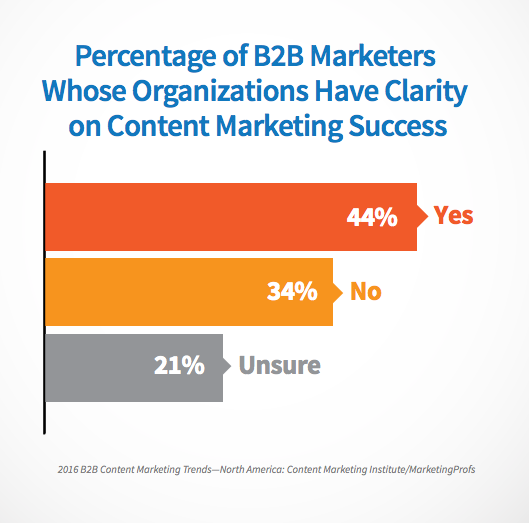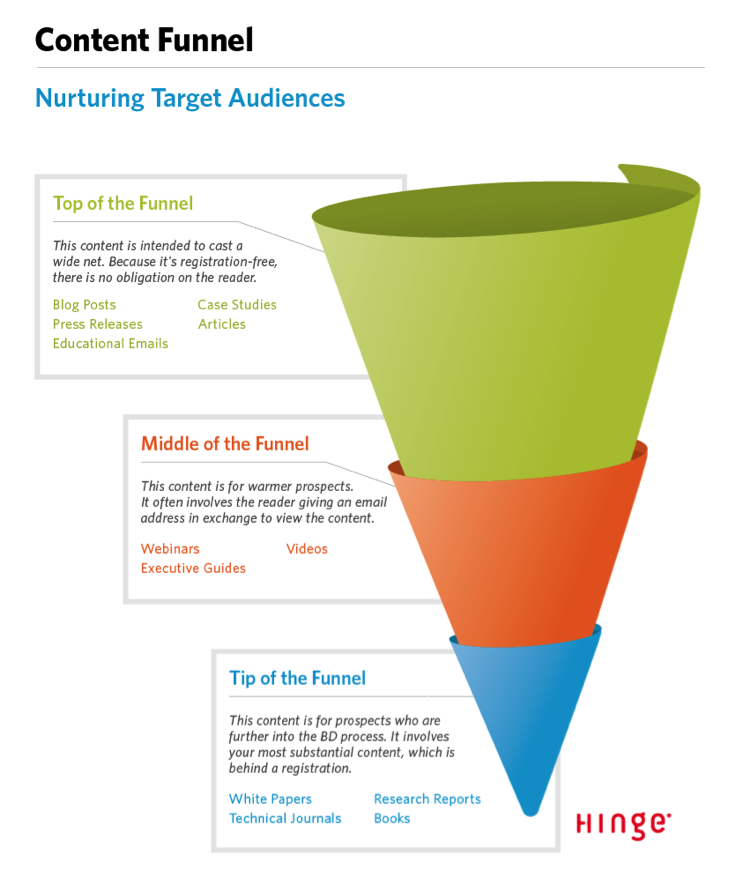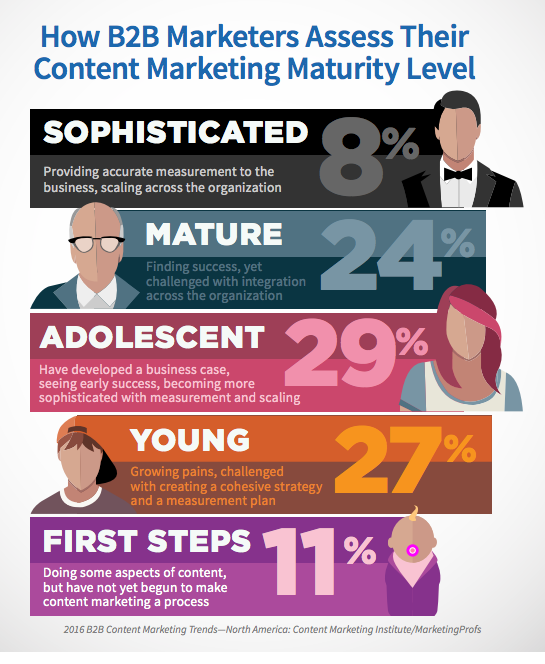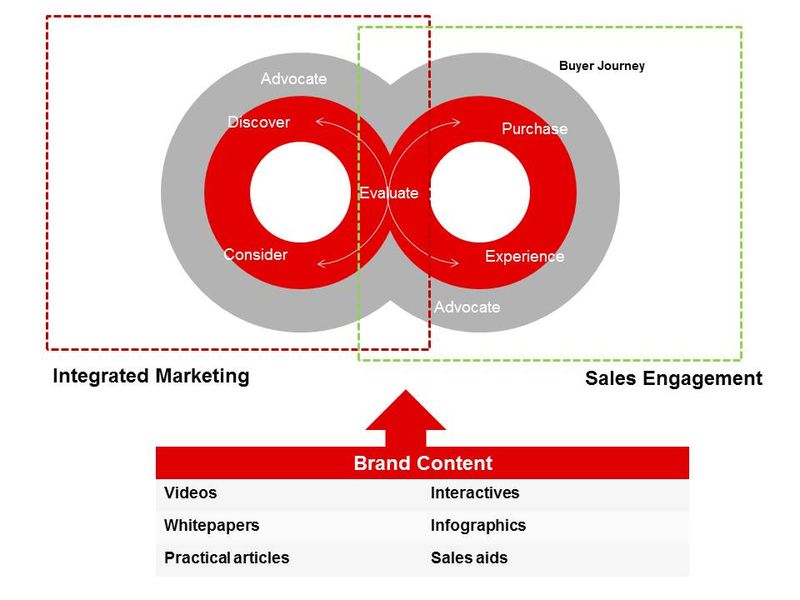Is Your Content Marketing Worth All The Effort? Consult Our 10 Point Checklist
Table of Contents
If you’re like 88% of B2B marketers, you use content marketing. If you’re like 70% of B2B marketers, you know your content marketing strategy isn’t that effective or you’re unsure if they’re effective.
The average B2B company spends 28% of its annual marketing budget on content marketing and more than 50% of companies planned to increase that in 2016 and beyond.
These numbers from the Content Marketing Institute’s 2016 B2B Content Marketing Benchmarks, Budgets, and Trends report paint an interesting picture:
A high percentage of B2B marketers spend a ton of money and time on content marketing but really have no idea if it’s working or not. With close to 90% of us using content marketing, we’re all in agreement that it makes sense in theory – connect your prospects and customers with your company’s products and messages in a way that’s natural, informative, easy to consume and not pushy.
But why can’t we figure out if it’s working? How can we do content marketing in a way that tells us we’re getting real ROI for our efforts?
The good news? You can! With a little structure, up-front work and consistency, your content marketing can yield recognizable results. Luckily, to make things easy, we have made a checklist.
You’ll be able to measure if your content marketing strategy is working if:
1. You understand what “working” means
First things first – if you don’t know where you’re going, it’s hard to know if you’ve arrived. Make sure you’re setting the right kinds of goals for your content.
What does a successful content strategy look like for your business? How to find if your marketing is working and what about sales? Product? Customer success?
Some marketers set their intentions through “mission statements” – the CMI survey says only 28% of marketers do that, but 77% of the most effective content marketers have a clear sense of what “success” looks like.
For example, your statement of success could look something like:
“A successful content marketing strategy for my business will use educational content to create better-educated and better-qualified leads for our marketing and sales teams. It will also provide use cases for our product marketers and content for customer success to improve the way our customers work with our product.”
It’s not a specific goal, but it gives your team a clear vision of what should be happening when your content strategy works.
2. You’ve set measurable goals
OK, so now you know what success looks like for your content strategy. Next question: how will you know you’ve succeeded?
The best business goals can be measured with the tools available to you. One of the most popular frameworks for setting action-oriented goals is the SMART acronym:
Specific
Measurable
Agreed upon
Realistic
Time-Based
You’ll also need to consider the different goals at each stage of your customer’s journey through your content. Most marketers segment this in terms of the funnel: top, middle and bottom.
Source: Social Media Today
Top of the funnel – Awareness and Attraction stage
At this stage, you’re working to help people recognize a specific problem they’re having. Content at this stage should be educational, address your audience’s pains and avoid an overly sales-y tone.
Goals you would set at this stage would be things like, “Grow traffic to cornerstone content about account-based marketing by 20% in 3 months.”
Middle of the funnel – Consideration stage
In the middle stage, people are now more aware of their pain and that they should be thinking of ways to solve it.
Here’s where you start to introduce the idea that your company might solve their problem and draw them a little deeper into your funnel. You’ll do things like lead nurturing here, where you keep in touch with prospects who expressed interest in your content and gave you an email address in exchange for something you created.
The goals you create for the content at this stage might be something like, “Increase email list subscribers by 40% in 6 months.”
Bottom of the funnel – Decision and Closing stage
Once your prospect understands that a) they have a problem they should be solving and b) your company solves that problem, then they’ll be ready for conversion-oriented content. Here’s where you convince them that your product is worth purchasing.
The goals you create for this level of content will be related to conversions – did people buy? Remembering the SMART acronym, you might make it, “X new customers per content offer,” or “Deliver X sales qualified leads (SQLs) to the sales team every month.”
3. You’re tracking the business-wide content metrics that matter
Stating SMART goals sets you up for better tracking. Now you know what you’re aiming for, and you can work on how to measure it.
You’re spending a ton of effort (and thus, money!) on your content marketing efforts – how will you know what it’s really costing you to reach those goals you set?
This is the heart of your content marketing return on investment (ROI), and it comes from tracking the right big-picture metrics. Two of the most important are:
Cost of Acquiring a Customer from Content Marketing (CAC)
This is the make-or-break-you metric. Acquiring a customer through content marketing costs money – you need to know exactly how much. You can calculate this via an equation:
Cost of your content marketing effort over a specific period of time / divided by the number of customers acquired directly attributable to content efforts over the same period of time
To be able to calculate that number, you’ll need to know how much time, money, and other resources you spent doing content marketing.
You’ll also need to be able to track a prospect who came into your funnel through your content all the way to a purchase decision. The best way to do that is via marketing automation platforms that let you apply a tag to a person when they enter your content ecosystem. That tag follows them all the way until they become a paying customer.
Customer Lifetime Value for Customers Acquired Through Content Marketing (CLTV)
While leading content marketing experts like Kissmetrics call CAC the “one metric that can determine your company’s fate,” it’s important to understand that you can’t use CAC in a vacuum.
For example, what if you find out that your CAC is $20. Every customer you gain through your content marketing efforts costs you $20.
So…now what? Is that good? Bad? How do you know?
You can only grade that CAC if you put it in the context of how much that customer will be worth to you in the long run.
That metric is called customer lifetime value (CLTV or just LTV).
This tells you how much customers you gain through content marketing are likely to spend with your company over a typical customer lifetime.
This metric tells you tons of important things. It’s how you learn if your customers through content marketing differ in any way from customers acquired through other means.
Do they spend more than customers you get through paid acquisition? Less? Are they interested in different products?
It also tells you if your CAC is too high or low. If the customers you acquire through content marketing spend an average of $1000 over their lifetime, then you may deduce that it’s worth spending $20 to acquire them.
4. You’re tracking the content-level content metrics that matter
Go beyond looking at things like “traffic.” What are your conversion-level metrics telling you? Make sure you’re digging a little deeper and looking at your numbers per piece of content.
Here are a few things you can be looking at for every piece of content you produce:
- Length of time on page: You have to be a little careful of putting all your stock in this statistic, because it doesn’t tell you anything about whether someone was reading the entire time or if your page just sat open in their browser, but it’s a pretty useful stat to triangulate with other engagement numbers.
- Scroll depth: This stat measures how far readers scrolled through your written web content. You can use the video equivalent of minutes watched for video content.
- Conversions on your calls-to-action: Of course, conversions are always the point, but this stat can tell you a lot about effectiveness too. You can test what kinds of CTAs work best (in-line, end of the page, designed or text-based), or see what kinds of content prompt people to convert the most.
- Social shares: Like time on page, this stat isn’t a standalone indicator because it doesn’t tell you about engagement and may have nothing to do with, but it’s a good one to track.
- Traffic sources: The proportion of direct, search, and referral traffic to specific content pieces can tell you a lot about what’s effective. For instance, if you’re getting a lot of referral traffic from a forum like GrowthHackers or Inbound.org, you can compare it to other cross-posting you do.
All of this will give you a much better sense of what’s making your content strategy work – or not. Emerging trends can help you decide things like what type of content to produce, lengths of content, which pieces give you the most ROI and more.
5. You can project success at each stage
You wouldn’t expect your two-year-old to play a Mozart concerto the way an adult could.
A lot of content marketers measure “maturity” when it comes to content the same way – you can’t expect as much of your brand-new content marketing effort as you can of a fully mature strategy.
Your definition of success and your goals should evolve as your content marketing strategy matures.
New to the game
This stage covers everything from “let’s try this content marketing thing” to at least a year of consistent content production.
Content marketing is a long game. You need to give yourself time to find the right audiences, figure out the right publishing consistency and promotion strategy, give your audience a chance to engage with your content and become loyal consumers, build your lists – you get the idea!
Your goals at this early stage will be related to growing your channels and getting enough traffic to be able to experiment and test. You’ll be looking at things like:
- Email subscriber lists growth
- Traffic to your main channels
- Social platform growth
- What types of content produce your best engagement
Humming right along
Once you’ve passed about a year of consistent content production and you’ve seen some solid growth in your channels, you can think about adjusting your goals. You’re an established content brand now. You have people who read or watch what you create.
At this point, you’ll have enough data to start creating your own benchmarks (more on that later), and understand what you can expect from your content operation.
Your goals should get much more specific and be tied to specific outcomes: a certain percentage of email list growth or numbers of sales-qualified leads, for instance.
You should also be able to start testing more effectively. Use A/B split tests and controlled marketing experiments to figure out new ways to create and deliver content – complacency is the enemy of success when it comes to content.
Seasoned content producers
At this point, you should be seeing some serious results across your business. You may still be ironing out different aspects of measurement or getting content to work across all your internal teams (more on that later), but overall, you’re on track to meet your more advanced goals, or you’ve at least run enough tests that you understand what works for your audience.
For content marketers at this level, the goals shift to using content ROI to drive company initiatives forward. If you know you can expect a certain return – say a 22 percent conversion rate from your SlideShare channel – you can use that information to create specific strategies.
Let’s say you need content to support an enterprise-level account-based sales push. Knowing what you know about your audience and the way they respond to content, you can create a SlideShare-based lead magnet with the expectation of a certain return on the cost and effort to create that piece.
6. You’re using benchmarks
Industry-wide benchmarks like the CMI report we’ve been referring to can be enormously helpful when you’re starting out and unsure what others are doing. Understanding trends and best practices can help you experiment with what works for your company.
Ultimately, though, you should be benchmarking against your own successes.
Remember when we talked about what “success” means for your company? The answer to that question will be different for everyone. It’s little use benchmarking against other companies when their answer might be pretty darn different.
For example, a company’s click-through rate for a certain type of call-to-action might be 80 percent. Naturally, you’re thinking that’s an awesome click-through rate and you might rush to implement that same CTA. But their approach might not work in your industry, and your customers might respond differently.
Which is more useful?
- Knowing another company did way better than you on their recent email drip campaign, or
- Knowing you once did way better on an email drip campaign than your most recent one?
In situation number one, you’ll never know enough to really iterate on that information. In scenario two, you can take concrete steps to assess what went wrong, because you know your prospects should have responded better.
7. Your internal teams use content effectively
Content isn’t just for marketing. Your content strategy can span your entire company.
One sign of a fully integrated and effective content strategy? When teams other than your content marketing team seek out your content and use it well for their own roles.
Sales trust your sales enablement content. Customer success relies on your content on a daily basis to help customers succeed with your product. Your events team routinely references your content on the exhibit hall floor when visitors ask where they can learn more about the company.
Source: SocialMediaToday
Those scenarios only happen if your content aligns with all of those teams’ missions as well – and when that happens, job well done!
8. Your prospects reflect your messaging back at you
If your content marketing strategy is good enough to successfully create content loyalists out of strangers, you’ll start to see an interesting phenomenon with your prospects: As they move further down your funnel, they should start to absorb your marketing messages and reflect them back at you as they engage with your company.
Imagine this scenario:
Someone who knows little about graphic design but wants design work done for their company might approach a design agency’s content knowing little about what they want.
They start to consume articles about color theory, the latest design trends, what people should understand about designers. They attend webinars about user experience design and the way design shapes customer behavior. Throughout this process, the agency is trying to teach the prospective customer one message: good design makes your product easier to use.
Through that process, they’re absorbing that message. By the time they’ve reached the point where they’re talking to a salesperson or making a purchase, they have internalized the idea that good design will make their product easier to use.
9. Your content promotes itself
We’ve talked a lot about metrics and funnels and goal-setting in our earlier points. Here’s one thing every marketer should also know. Your content marketing strategy needs to pass the suck test and the share test.
On a gut, instinctual level…does your content suck? If you have the gut feeling that it’s possible that maybe it could potentially sort of, well…suck…then there’s your first problem.
If you’re shaking your head vehemently and thinking, “No way, our content does not suck!” then you move on to the next test.
Would you share your own content? Is it awesome enough that you’d want everyone you admire to associate you with that content?
(For instance, a calculator from Outgrow makes a pretty darn cool and shareable piece of interactive content. Just saying…)
These simple, no-data-needed tests help you iron out one of the biggest reasons content marketing strategy fails. Simply put, your content needs to be good. There’s too much stuff out there now for mediocre content to get you anywhere.
Your audience will do the same instinctual “Does it suck?” and “Should I share this?” test in their own minds. Creating brand loyalists for your content requires content that’s a cut above.
If you’re like us and you’d really prefer some kind of metric to go along with the “How good is our content, really?” question, you can look at things like the percentage of referred visitors or your social share statistics.
10. You’re so busy you’re no longer wondering if it’s working 😉
OK, so this is a little facetious, but you’ll find that this one’s true too. It’s easy to spend a lot of time wondering if your content marketing is working…when it’s clearly not working. If you’re not getting traffic or none of your visitors take the step to become leads, then you’re probably wondering, “Is this working?”
Now, if your pipeline is packed and you’re pleased with your attributable content metrics and you’re delivering excellent leads and fulfilling all your goals, then you’re probably not wondering if your content marketing strategy works – it clearly does.
If you’ve read through this post because you’re not sure if your content efforts work, then take a look back through our signs of a successful content marketing strategy. Think about each one as it applies to your company, and remember that content marketing is all about the right content in front of the right people for the right reasons.







